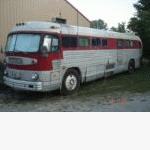| Author | Message | ||
| Sean Welsh (Sean)
Registered Member Username: Sean Post Number: 1228 Registered: 1-2003 Posted From: 67.142.130.12  Rating: |
Yesterday during the Round Table session (a misnomer, since I ended up as the only panelist) a question was asked about dual hookups for LPG cylinders. That question got answered, but in the process we evaluated a dual-cylinder installation on a coach near the seminar pavilion. Those cylinders were properly secured and mounted, and there was adequate venting in the compartment, however I found two problems with the installation. One was that the compartment had a locking door, and the second was that the compartment lacked the required exterior labeling. I was asked what the specifications for that labeling are and during the session I could not dig them up in the code, and I promised to do so after the seminar and report the answer back here on the board. It follows forthwith. I said yesterday that I thought this requirement might be in either NFPA 1192 or perhaps 49 CFR which is the code that dictates federal requirements for transportation of gas cylinders. However it turns out not to be a federal requirement but rather one dictated by the state of California. Specifically it is CVC section 27909, and it requires any compartment containing LPG tanks or cylinders to be labeled on the exterior of the vehicle with the marking "LPG" in one inch high letters of a contrasting color. The requirement applies to any vehicle entering the state, and consequently most RV manufacturers conform to this requirement. As it turns out if you never bring your vehicle into California you need not comply with this regulation. That said, I recommend it anyway. The intent of this code provision is to allow firefighters to quickly identify where the cylinders are located in the event of a fire, so that a catastrophic explosion known as a BLEVE can be averted. The provision regarding the prohibition of locks is actually in NFPA 1192 and thus is a requirement in most states. It prohibits having a lock of any kind on any compartment door that encloses an LP gas valve; here again the intent is to allow firefighters swift and unimpeded access to the valves to turn off the gas supply in the event of an emergency. In summary I recommend that you both remove any locks from any LP compartment doors and also label the compartment door with LPG in 1" high letters. Not only will this increase your safety but it will also put you in compliance with the law in all 49 continental states. Thanks to everyone who participated in the round table yesterday and especially to those who sent in their questions via the chat room. -Sean http://OurOdyssey.BlogSpot.com | ||
| Dal Farnworth (Dallas)
Registered Member Username: Dallas Post Number: 252 Registered: 7-2004 Posted From: 98.20.54.145  Rating: |
Thanks, Sean. Although I am familiar with the commercial end of the regulations on DOT and ASME tanks, I did not realize that the compartment needed to be marked. I will rectify that as soon as I get the new siding on the bus. Does this marking need to be the vinyl type sticker or may it be painted on with auto style paint. One item I would like to point out about the DOT tanks. They must have an original certification date of less than 12 years, (There are some that require certification after 10 years, but those are rare), for tanks of 100 pounds capacity or less. If the certification is expired, the tank can be recertified for a small charge and will be good for five more years. Caution: Some states, notably Alabama, Louisiana and Mississippi have a tendency to use a paper recertification sticker. Unfortunately, this isn't recognized by some other states and has the unfortunate habit of washing off or fading with time. Here we stamp the recertification date into the metal along with our license number. Another problem is the valve, if the tank is 40 pounds capacity or less, it must have an OPD valve. The old style valves are no longer legal. If you covered this in your seminar, please forgive me. I only wish to save people from possible problems. | ||
| Sean Welsh (Sean)
Registered Member Username: Sean Post Number: 1229 Registered: 1-2003 Posted From: 67.142.130.12  Rating: N/A |
Dal, Thanks. With regard to the California labeling statute, the requirement is only that the letters be 1" high and of a contrasting color. They could be painted on or stickers/decals. We did discuss OPD valves and how to identify them in the session. I did not go into the certification requirements, but you are of course correct that original certified tanks are only good for 12 years and then need to be re-certified. If you use 20lb/5gal cylinders, an easy thing to do is take them to one of the places that just exchanges your empty cylinder for a full one, just before they expire. Ensuring you get a certified tank and taking the expired ones out of service is one of the services the exchange places provide. -Sean http://OurOdyssey.BlogSpot.com |